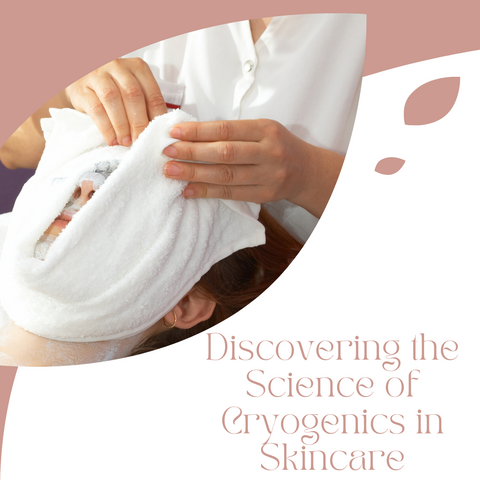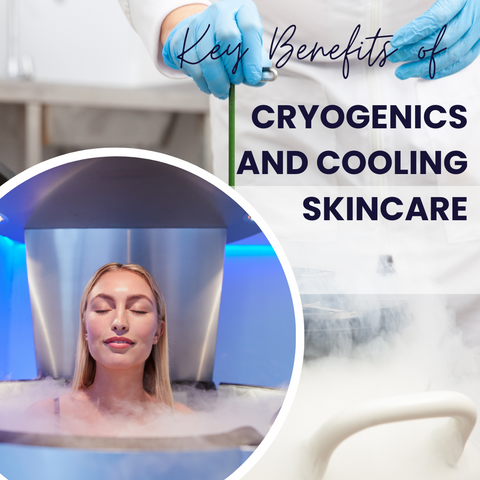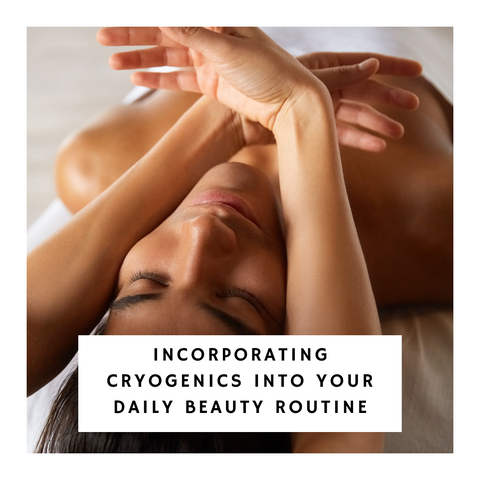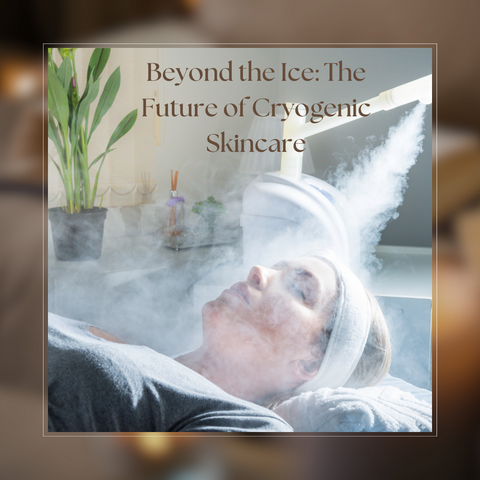Cryogenics, or the use of extremely freezing temperatures in skincare, has gained popularity as a revolutionary method for skin rejuvenation. This trend is using freezing temperatures or cryotherapy in various skincare procedures to provide a variety of potential benefits. Regardless of the potential benefits, it is critical to use cryogenic skincare treatments with caution, especially on delicate skin, and to follow instructions to avoid side effects such as frostbite or skin irritation caused by intense cold. Before attempting cryogenic treatments, consult with a skincare specialist to discover if they are appropriate for your skin type and condition.
Discovering the Science of Cryogenics in Skincare

Cryogenics in skincare is the use of extremely cold temperatures for a variety of skin advantages. The science behind cryogenics in skincare is based on physiological reactions that occur when the skin is subjected to freezing temperatures, such as vasoconstriction, anti-inflammatory effects, circulation stimulation, collagen formation, temporary numbness, and improved product absorption. While skincare cryogenics show promise for various skin advantages, it's important to proceed with caution, especially if you have sensitive or reactive skin. To guarantee safety and suitability for your skin type and condition, follow the directions and visit a skincare specialist.
Understanding Cryogenics and Its Role in Beauty
In the beauty business, cryogenics refers to the use of extremely low temperatures for a variety of aesthetic and skincare applications. It is a method of using freezing temperatures to provide medicinal and cosmetic benefits to the skin and body. Cryogenics in beauty is broken down into cryotherapy, skincare advantages, localised applications, cryogenic facials, collagen stimulation, pain relief and muscle recovery, and potential hazards. However, it is critical to seek professional advice and ensure the safe and proper usage of cryogenic therapies, particularly when used for skincare. Before undertaking any cryogenic beauty treatments, it is critical to understand the dangers and advantages. Consultation with a skincare specialist or dermatologist can assist in determining whether cryotherapy or cryogenic skincare is appropriate for specific skin issues and disorders.
The Process and Effects of Cryotherapy on Skin
Cryotherapy is a medical practise that involves subjecting the skin or body to extremely low temperatures. The following summarises cryotherapy's procedure and skin-related effects:
The cryotherapy procedure:
-
Whole-Body Cryotherapy (WBC): During a brief period of time, usually two to four minutes, patients are exposed to extremely low temperatures, which typically range from -100°C to -140°C (-148°F to -220°F). This exposure is accomplished through the use of liquid nitrogen or refrigerated cold air.
-
Localised Cryotherapy: Cryotherapy can be used to treat specific body or facial areas by using specialised instruments such as cryo wands, cryo globes, or cryo rollers. These devices are used to apply cold therapy directly to certain areas of the skin.
Cryotherapy's Effects on Skin:
-
Reduced Inflammation: Cold temperatures cause vasoconstriction, which reduces blood flow and inflammation in the treated area. This can help to reduce redness and soothe irritated skin.
-
Pore Tightening: Cold exposure can temporarily tighten the skin and pores, giving the skin a smoother appearance and reducing pore visibility.
-
Puffiness Reduction: Cryotherapy can help reduce puffiness, particularly around the eyes and in swollen facial areas.
-
Improved Circulation: Cold exposure increases blood circulation, which promotes oxygenation and nutrient delivery to skin cells, potentially improving skin health.
-
Skin Rejuvenation: Over time, regular cryotherapy sessions may promote collagen production, resulting in improved skin elasticity and a more youthful appearance.
-
Pain Reduction and Muscle Recovery: Sports medicine uses cryotherapy because of its ability to reduce inflammation and relieve soreness in the muscles.
-
Brief Numbing Effect: Prolonged exposure to extremely low temperatures can temporarily numb the skin, which may help with some skin disorders or mild discomfort.
While decreased inflammation, tighter pores, and increased circulation are just a few of the potential skincare advantages of cryotherapy, it is important to use caution and seek professional advice to guarantee safety and efficacy for specific skin issues.
Comparing Traditional Skincare with Cryogenic Methods
There are differences between cryogenic skincare techniques and conventional skincare methods when it comes to skincare. The two are contrasted as follows:
Traditional Skincare:
-
Time-tested Procedures: Conventional skincare is based on tried-and-true procedures like washing, hydrating, exfoliating, and applying different topical products (creams, serums, masks) with reputable ingredients and formulations.
-
Diverse Ingredients: To address particular skin issues like hydration, anti-aging, acne, or pigmentation, traditional skincare frequently uses a wide range of ingredients like antioxidants, retinoids, hyaluronic acid, and botanical extracts.
-
Routine-Based: The focus of traditional skincare is on a consistent regimen catered to specific skin types and issues. It emphasises regular daily maintenance to keep skin healthy and gradually treat particular problems.
-
Gradual Results: The health and appearance of the skin can improve gradually with traditional skincare regimens, which frequently call for long-term consistency.
Cryogenic Skincare:
-
Exposure to Extreme Cold: Cryogenic skincare procedures usually entail the use of cryotherapy chambers, localised cold treatment instruments, or cryogenic facials, which involve exposure to extremely low temperatures.
-
Concentrated on Temperature Effects: Cryogenic techniques take advantage of the benefits of low temperatures for the skin, such as decreased inflammation, tightened pores, enhanced blood flow, and possibly even stimulation of collagen.
-
Short-Term Procedures: Cryogenic procedures typically take only a few minutes and have immediate and transient benefits like less puffiness and a more rested appearance.
-
Potential Risks: Use of cryogenic skincare should be done with caution, as there is a chance of skin damage if not done correctly. Extreme cold can cause irritation or frostbite.
Both traditional skincare and cryogenic treatments have advantages and disadvantages. Combining elements of both approaches could result in a full skincare regimen that combines the benefits of traditional regimens with the immediate impacts of cryogenic skincare for well-rounded skin care. However, it is critical to pursue cryogenic therapies with caution, considering individual skin sensitivity and potential hazards. Consultation with a skin care professional can assist in determining the best approach for specific skin issues and conditions.
Key Benefits of Cryogenics and Cooling Skincare

Cryogenics and cooling skincare methods have a number of potential skin benefits. Here are a few key benefits:
Benefits of Cryogenics and Cooling Skincare:
-
Reduced Inflammation: Cryotherapy or cooling skincare can help reduce inflammation by constricting blood vessels, calming redness, and soothing irritated skin conditions such as rosacea or acne.
-
Pore Tightening: Cold exposure can temporarily tighten pores, smoothing the skin and potentially reducing the accumulation of debris and oil that contributes to the appearance of enlarged pores.
-
Puffiness and Swelling Reduction: Cryogenic treatments can help reduce swelling by constricting blood vessels and emptying extra fluid from tissues, especially around the eyes or in areas prone to puffiness.
-
Improved Circulation: Cooling skincare can increase blood flow, resulting in improved oxygenation and nutrient delivery to skin cells. Improved circulation promotes overall skin health and a more youthful appearance.
-
Soothing Sensations: The cold temperature provides a refreshing and soothing sensation to the skin, providing immediate relief, particularly for heat-related discomfort or post-procedure skin irritation.
-
Skin Rejuvenation: Exposure to cold temperatures on a regular basis may stimulate collagen production, resulting in improved skin elasticity and a more youthful appearance over time.
-
Temporary Numbing Effect: Immediate exposure to cold can provide a numbing effect, potentially relieving discomfort from certain skin conditions, minor irritations, or post-procedure treatments.
-
Fast Revivification: Cryogenic skincare techniques provide rapid revivification, which makes them well-liked for pre-event treatments or for those looking for instantaneous skin appearance improvements.
-
Complementary to Skincare Routines: By offering instant benefits like lowering puffiness or relieving irritation, cooling skincare treatments can support conventional skincare regimens.
When performed correctly and under professional supervision, cryogenic treatments and cooling skincare methods can provide a variety of skin benefits, providing immediate relief and contributing to overall skin health and appearance.
Tightening Pores and Enhancing Circulation
Tightening pores and improving circulation are two key benefits of skincare methods, which include some cryogenic or cooling skincare approaches. Here's how these techniques can help with these specific skin enhancements:
Tightening Pores:
-
Cold Temperature Effects: Cryogenic treatments or cooling skincare can temporarily constrict blood vessels and tighten the skin, causing pores to appear smaller.
-
Pore Visibility is Reduced: When pores tighten due to cold, they appear smaller, giving the skin a smoother and more refined texture. This effect is especially noticeable after cryotherapy or the use of cooling skincare products.
-
Debris Removal: Cold temperatures can help with the removal of dirt, oil, and debris that may accumulate in pores. This can help to reduce the appearance of enlarged pores over time.
-
Refined Skin Texture: Tightened pores may result in a more uniform skin texture, which may make flaws less noticeable while also giving the appearance of smoother skin.
Enhancing Circulation:
-
Stimulation of Blood Flow: Applying cooling skincare techniques or cryotherapy to the skin can help to increase blood flow. Blood vessels dilate in colder temperatures after first constricting, which improves blood flow.
-
Oxygenation and Nutrient Delivery: Increased circulation provides the skin cells with greater oxygen and nutrients. This may enhance skin vigour, encourage cell renewal, and result in a more radiant complexion.
-
Toxin Removal: Toxins and waste products are drawn out of skin cells by improved circulation, which keeps the skin clear and healthy.
-
Decrease in Puffiness: Improved circulation helps the tissues, especially those around the eyes and in areas that are prone to swelling, to expel extra fluid, which in turn reduces puffiness.
While cryogenic treatments and chilling skincare methods can provide temporary tightening of pores and increased circulation, the effects are usually transient. Consistent use may aid in the maintenance of these advantages, but long-term improvement in pore size or overall skin health may necessitate a combination of treatments and a thorough skincare plan. Furthermore, these treatments must be carried out with caution, especially when dealing with extremely cold conditions, to avoid potential side effects such as skin damage or inflammation. Consultation with a skincare specialist can provide information on safe and effective strategies for achieving these skin enhancements while taking specific skin types and issues into account.
Soothing Effects of Cryogenics on Sensitive Skin
Cryogenics, specifically cryotherapy and cold skincare procedures, can be soothing to sensitive skin. Here's how these treatments can help those with sensitive skin:
-
Reduced Inflammation: Sensitive skin can be soothed and inflammation reduced with the use of cooling skincare products or cryotherapy. It relieves irritation and lessens redness by narrowing blood vessels.
-
Soothing Sensation: Sensitive skin experiences an instant cooling and soothing effect from the cold, which helps to reduce discomfort and heat-related sensations.
-
Diminished Skin Sensitivity: Cryogenic treatments have a numbing effect that may temporarily lessen skin sensitivity in those with sensitive skin conditions.
-
Reducing Redness: Using cooling skincare techniques can help reduce redness that comes with having sensitive skin, leaving the complexion looking calmer and more balanced.
-
Calming Inflamed Skin: Certain skin conditions like rosacea or eczema, as well as environmental aggressors, can all relieve irritated skin through cryotherapy treatments.
-
Puffiness Reduction: By narrowing blood vessels, cryogenic treatments can help people with sensitive skin who are prone to puffiness or swelling lessen these effects.
-
Individual Sensitivity: While cryotherapy and cooling skincare can benefit sensitive skin, everyone reacts differently. Some people may find the cold temperature uncomfortable, or they may have adverse reactions due to their sensitive skin.
-
Professional Advice: Before undergoing cryogenic treatments, consult with a skincare professional or dermatologist, especially if you have sensitive skin or skin conditions. They can advise on appropriate methods and ensure that treatments are safe for sensitive skin.
To ensure safety and effectiveness, cryogenic treatments for sensitive skin must be approached with caution and under the supervision of a professional. While these methods may provide soothing effects and potentially reduce sensitivity, individual reactions may vary, and some sensitive skin types may be more susceptible to negative effects. Before undergoing cryotherapy or cooling skincare treatments, it is best to perform a patch test and seek professional advice, especially if you have sensitive or reactive skin.
Anti-Aging Advantages of Cold Temperature Treatments
Cryotherapy and cooling skincare methods, for example, can provide several potential anti-aging benefits for the skin:
-
Reduced Inflammation and Puffiness: Cold temperatures can constrict blood vessels, reducing inflammation and puffiness. This effect can make the skin appear firmer and reduce the appearance of under-eye bags or facial swelling, giving the appearance of being more youthful.
-
Tightening and Smoothing Effect: Cryotherapy and cooling skincare can temporarily tighten the skin due to vasoconstriction, resulting in a smoother appearance and possibly reducing the appearance of fine lines and wrinkles.
-
Collagen Production Stimulation: Cold temperatures may stimulate collagen production. Collagen is necessary for skin elasticity and firmness, which can contribute to a more youthful appearance.
-
Improved Circulation: Cold treatments that increase blood flow can improve skin health by delivering more oxygen and nutrients to skin cells. This can help with skin rejuvenation and keeping a youthful glow.
-
Pore Minimization: Cold temperature treatments can temporarily tighten pores, making them appear smaller and less noticeable, contributing to the youthful skin texture.
-
Temporary Skin Tightening: Cold treatments' immediate skin tightening can provide a temporary lifting effect, reducing the appearance of sagging or lax skin.
-
Reduced Redness and Irritation: Cold therapy can soothe irritated skin, calm redness, and alleviate heat-related sensations, all of which are frequently associated with ageing skin or skin conditions such as rosacea.
While cryotherapy and cooling skincare procedures can provide instant anti-aging benefits such as reduced puffiness and temporary skin tightening, long-term anti-aging results often necessitate constant use and, in some cases, a mix of treatments and skincare regimens. These cold temperature treatments can be used as part of a full anti-aging regimen, but they should be used with caution and under the supervision of a professional to guarantee safety and effectiveness.
Incorporating Cryogenics into Your Daily Beauty Routine

Incorporating cryogenics or cold temperature treatments into your everyday beauty routine can provide your skin with refreshing benefits. Here's how to incorporate cooling skincare products, cryotherapy gear, a daily routine, and occasional cryotherapy treatments into your routine.
Safety Considerations:-
Individual Sensitivity: Pay attention to the reaction of your skin. Before using new cooling skincare products or cryo tools on sensitive or reactive skin, conduct a patch test.
-
Professional Advice: Before incorporating intense cryotherapy treatments into your routine, consult with a skincare professional, especially if you have specific skin conditions or concerns.
General Tips:
-
Consistency: Use these methods on a regular basis to reap the most benefits. However, use them with caution to avoid overexposure to extreme cold, especially for long periods of time.
-
Adapt to Your Skin: Depending on your skin's response and needs, adjust the frequency and intensity of cold treatments.
By incorporating cryogenics or cooling skincare into your daily routine, you may be able to reap the benefits of refreshing and rejuvenation while also supporting your overall skin health. Always pay attention to your skin and tailor your routine to its specific needs and responses.
Selecting the Best Cryogenic Skincare Products
Choosing the best cryogenic skincare products entails taking into account a variety of variables to ensure they are compatible with your skin type, issues, and preferences. Here's a checklist to help you decide:
Take into account your skin type and concerns:
-
Sensitive Skin: To avoid potential irritation from extreme cold, look for gentle formulas containing soothing ingredients such as aloe vera or chamomile.
-
Dry Skin: Choose hydrating products to avoid the excessive dryness that can sometimes accompany cold treatments.
-
Oily or acne-prone skin: Non-comedogenic formulas with gentle cooling effects can help reduce acne, inflammation and control excess oil production.
-
Ageing or Fine Lines: Anti-aging products containing collagen-boosting ingredients or antioxidants can supplement cryogenic treatments.
Look for the following key ingredients:
-
Menthol: This ingredient has a cooling effect and can help soothe the skin.
-
Cucumber: Cucumber is well-known for its cooling and hydrating properties, making it ideal for reducing puffiness and irritation.
-
Aloe Vera: Aloe vera has soothing properties that are ideal for sensitive or irritated skin.
-
Hyaluronic Acid: Hyaluronic Acid Aids in skin hydration, which is important when considering potential dryness from cold treatments.
-
Green Tea Extract: Has antioxidant properties and can help reduce inflammation.
How to Safely Use Cooling Skincare Products
Using cooling skincare products properly entails incorporating them into your regimen while keeping your skin's sensitivity and the specific product's recommendations in mind. Follow these procedures to use these goods safely:
-
Perform a Patch Test: Before using a new cooling skincare product on your face, test it on a tiny patch of skin (such as your inner forearm) to see if there are any adverse reactions or allergies. Check for signs of irritation, redness, or discomfort after 24-48 hours.
-
Begin Gradually: Incorporate cooling skincare products into your routine gradually to allow your skin to adjust. Begin by using the product once every few days or as recommended on the packaging.
-
Cleanse First: Begin your skincare routine by cleansing your face. Before applying cooling products, remove any dirt, oil, or makeup with a gentle cleanser.
-
Apply with Clean Hands: Before applying the product, make sure your hands are clean to avoid contamination and potential skin reactions.
-
Follow Instructions: Stick to the recommended usage frequency and application method listed on the product label or in the manufacturer's instructions.
-
Avoid Making Eye Contact: Be cautious around the eyes. Some cooling products may irritate the eyes if they come into direct contact with them.
-
Layering Products: Apply products in the order of thinnest to thickest consistency (e.g., toner, serum, moisturiser). Before using thicker creams or SPF, use cooling products after cleansing.
-
Sun Protection: During the day, wear sunscreen, especially if you have been using cooling skincare products that could increase your skin's sensitivity to the sun.
-
Watch for Adverse Reactions: Be alert for any skin reaction, such as redness, itching, burning, or increased sensitivity. If you feel any discomfort, stop using it.
-
Modify Frequency: If you experience any irritation, cut back on how often you apply it or stop using it altogether until your skin heals. See a dermatologist if the irritation does not go away.
By following these steps and paying attention to your skin's reaction, you can safely incorporate cooling skincare products into your routine while minimising the risk of adverse reactions or irritation. Listening to your skin and adjusting product usage as needed is critical for a safe and enjoyable skincare experience.
Cryogenics for All Skin Types: Customization Tips
When it comes to cryogenics or chilling skincare for different skin types, customisation is necessary to guarantee that the treatment meets the demands of the individual. Here are some suggestions for tailoring cryogenic skincare to different skin types:
-
For Normal Skin: The majority of cooling products are well tolerated by people with normal skin. Choose items that provide a moderate cooling sensation without leaving you feeling overly dry. Choose products that hydrate the skin while also offering a refreshing sensation. For a well-balanced approach, look for components such as cucumber, aloe vera, or hyaluronic acid. Cooling skincare products should be used sparingly to preserve skin health without overstimulating the skin or potentially producing undesirable responses.
-
For Dry Skin: To avoid further dryness, choose cooling products with enhanced hydration. To lock in moisture, look for components like glycerin, hyaluronic acid, or shea butter. To avoid worsening dryness, use cooling skincare less frequently, perhaps 2-3 times per week. Avoid harsh cooling creams that may take away natural oils or further dehydrate the skin.
-
For Oily or Acne-Prone Skin: To avoid blocking pores or causing breakouts, choose cooling products that are oil-free and non-comedogenic. Choose cooling products that target inflammation and tighten pores without worsening oiliness. Choose lightweight solutions to avoid adding too much moisture to oily skin.
-
For Sensitive or Reactive Skin: To soothe and calm sensitive skin, look for cooling products that contain mild ingredients like chamomile, green tea, or aloe vera. Before using new cooling products, always perform patch tests to verify they do not cause irritation or allergic reactions. To avoid irritation, use cooling skincare sparingly, perhaps every few days.
-
For Combination Skin: Cooling agents should be used strategically to regions that will benefit the most, such as the T-zone for oil control or specific areas for pore tightening. Choose items that provide hydration while also controlling oil. Use cooling skincare products according to the needs of dry and oily parts of the face.
Customising cryogenic skincare for different skin types entails selecting appropriate formulations, changing frequency of use, and paying attention to individual skin sensitivities. By tailoring your cryogenic skincare practise, you can maximise the advantages while addressing specific skin conditions and maintaining skin health.
Beyond the Ice: The Future of Cryogenic Skincare

The future of cryogenic skincare holds exciting potential as technological advancements and innovative approaches in the beauty industry continue to evolve. The potential directions and advancements shaping the future of cryogenic skincare are technological advancements, ingredient innovation, personalisation and customization, sustainability and ethical practises, holistic wellness integration, and clinical applications. However, while anticipating these advancements, it is critical to remain cautious, particularly in terms of safety, regulation, and individual skin sensitivities. Consultation with skincare professionals or dermatologists will continue to be essential for the safe and effective implementation of cutting-edge cryogenic skincare practises.
Innovations in Cryogenic Skincare Technologies
In recent years, cryogenic skincare technology has improved dramatically, introducing new equipment and techniques. Among the primary advancements influencing the sector are sophisticated cryo devices, technology integration, cryogenic chemicals and formulations, at-home cryo solutions, clinical and therapeutic uses, and increased safety precautions. These advancements aim to provide more personalised, efficient, and user-friendly cryotherapy solutions while widening the spectrum of skincare advantages to meet the needs of a wide range of users. When incorporating new cryogenic skincare technology into routines, it's critical to proceed with caution, seek professional advice, and follow safety rules.
Balancing Cryogenic Treatments with Conventional Skincare
Balancing cryogenic treatments with traditional skincare practises entails combining the advantages of both procedures to improve skin health. Understanding cryogenic therapies, synergizing cryotherapy with conventional skincare, consistent conventional skincare practises, monitoring skin reactions, and professional advice are all ways to achieve a balance between cryogenic treatments and traditional skincare. You may maximise the benefits of both treatments for improved skin health and attractiveness by integrating them carefully and taking individual skin demands into account.
Expert Opinions on the Long-term Benefits of Cryogenics
Experts' perspectives on the long-term benefits of cryogenics in skincare differ. While some specialists recognise the potential benefits of cryogenics in skincare, most agree that further research is needed to fully grasp its long-term consequences. As a result, experts advise taking a cautious and personalised approach, emphasising the significance of combining cryogenic treatments with standard skincare practises as well as obtaining professional supervision for safe and effective use.
















